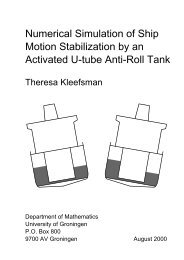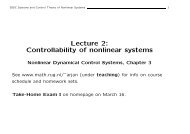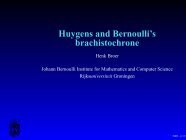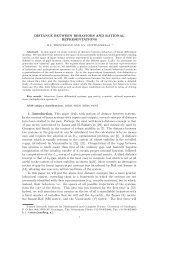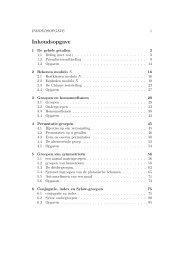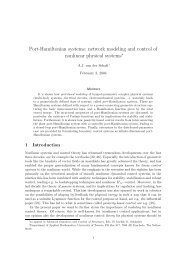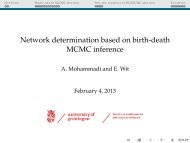Chaos and quasi-periodicity in diffeomorphisms of the solid torus
Chaos and quasi-periodicity in diffeomorphisms of the solid torus
Chaos and quasi-periodicity in diffeomorphisms of the solid torus
You also want an ePaper? Increase the reach of your titles
YUMPU automatically turns print PDFs into web optimized ePapers that Google loves.
4.3 Interpretations <strong>of</strong> <strong>the</strong> numerical results<br />
Most <strong>of</strong> <strong>the</strong> numerical study is based on <strong>the</strong> computation <strong>of</strong> Lyapunov exponents. Know<strong>in</strong>g<br />
<strong>the</strong> values <strong>of</strong> <strong>the</strong>se exponents gives some h<strong>in</strong>ts on <strong>the</strong> dynamics, though certa<strong>in</strong> ambiguities<br />
can occur. As discussed before, <strong>in</strong> cases <strong>of</strong> one positive Lyapunov exponent <strong>and</strong> two negative<br />
ones, one cannot guess whe<strong>the</strong>r <strong>the</strong> attractor is Hénon-like or <strong>quasi</strong>-periodic Hénon-like.<br />
Next we present a couple <strong>of</strong> elementary examples which illustrate how careful one must<br />
be <strong>in</strong> <strong>the</strong> <strong>in</strong>terpretation <strong>of</strong> <strong>the</strong> numerical results.<br />
Arithmetic effects<br />
The computed orbit can strongly depend on <strong>the</strong> k<strong>in</strong>d <strong>of</strong> arithmetics used <strong>in</strong> <strong>the</strong> computations.<br />
Let us return for a moment to <strong>the</strong> Lyapunov sums (35). Assume that <strong>the</strong>y are decreas<strong>in</strong>g<br />
on average <strong>and</strong>, <strong>the</strong>refore, give evidence <strong>of</strong> a negative Lyapunov exponent. However <strong>the</strong><br />
oscillations around a l<strong>in</strong>e with slope equal to <strong>the</strong> Lyapunov exponent can be very large. This<br />
means that local errors can be amplified by a big factor. If <strong>the</strong> amplification is large (before<br />
decreas<strong>in</strong>g aga<strong>in</strong>) <strong>the</strong> propagation <strong>of</strong> <strong>the</strong> numerical errors can show a completely different<br />
dynamics.<br />
To illustrate <strong>the</strong>se numerical effects, let us consider <strong>the</strong> follow<strong>in</strong>g toy model<br />
(x, θ) ↦→ (1 − (a + ε s<strong>in</strong>(2πθ))x 2 , θ + α), (36)<br />
which is <strong>the</strong> Logistic family, driven by a rigid rotation. Note that this is a particular case <strong>of</strong><br />
<strong>the</strong> family (2) for b = δ = 0, which, however, is not a diffeomorphism.<br />
First <strong>of</strong> all we take α small, such that a priori one may expect <strong>the</strong> system (36) to be<br />
not too far from <strong>the</strong> sequence <strong>of</strong> attractors correspond<strong>in</strong>g to <strong>the</strong> ‘frozen’ values <strong>of</strong> θ. We<br />
took (a, ε) = (1, 30, 0.30), <strong>the</strong>reby ensur<strong>in</strong>g that <strong>the</strong> frozen values <strong>of</strong> a + ε s<strong>in</strong>(2πθ) range<br />
over <strong>the</strong> <strong>in</strong>terval [1, 1.6]. In this doma<strong>in</strong> <strong>the</strong> attractors <strong>of</strong> <strong>the</strong> Logistic family range from <strong>the</strong><br />
period 2 s<strong>in</strong>k to <strong>the</strong> chaotic doma<strong>in</strong>, where <strong>the</strong> support <strong>of</strong> <strong>the</strong> <strong>in</strong>variant measure has a s<strong>in</strong>gle<br />
component (say, a ‘one-piece’ strange attractor). The value <strong>of</strong> α has been taken small (<strong>in</strong><br />
particular α = γ/1000, where γ is <strong>the</strong> golden mean) <strong>in</strong> order to move slowly through <strong>the</strong><br />
frozen systems, <strong>in</strong> an adiabatic way.<br />
As a start<strong>in</strong>g po<strong>in</strong>t we chose θ 0 = 0.6. The value <strong>of</strong> x 0 may be taken arbitrary, presently<br />
∑<br />
we picked x 0 = 0.123456789. While comput<strong>in</strong>g iterates <strong>and</strong> <strong>the</strong> Lyapunov sums LS n =<br />
n<br />
j=1 log(2a|x j|) we observe that LS n decreases (with some m<strong>in</strong>or oscillations) dur<strong>in</strong>g <strong>the</strong><br />
first 600 iterates. It reaches a value close to −665. Then LS n <strong>in</strong>creases (except for some m<strong>in</strong>or<br />
oscillations) for <strong>the</strong> next 800 iterates, reach<strong>in</strong>g a value close to −460. This implies that <strong>in</strong> that<br />
transient period, along <strong>the</strong> computed orbit, local errors <strong>in</strong>crease by exp(−460 + 665) ≈ 10 89 .<br />
It may be clear that errors <strong>of</strong> <strong>the</strong> order <strong>of</strong> <strong>the</strong> computer double precision accuracy will<br />
soon produce a departure <strong>of</strong> <strong>the</strong> vic<strong>in</strong>ity <strong>of</strong> <strong>the</strong> orbit that one would obta<strong>in</strong> with exact<br />
computations.<br />
In Figure 11 we present an example <strong>of</strong> this phenomenon. If <strong>the</strong> accuracy is not sufficient,<br />
say only 60 decimal digits, we may expect <strong>the</strong> same to happen, compare with <strong>the</strong> top right<br />
part <strong>of</strong> <strong>the</strong> figure. The lower left plot, computed with 150 decimal digits, displays that<br />
<strong>the</strong> attractor is <strong>in</strong>deed an <strong>in</strong>variant circle. When <strong>the</strong> computer accuracy changes, so does<br />
<strong>the</strong> computed orbit <strong>and</strong> hence also <strong>the</strong> Lyapunov sums change. With <strong>the</strong> ‘correct’ values<br />
<strong>the</strong> first m<strong>in</strong>imum <strong>of</strong> LS n (neglect<strong>in</strong>g period 2 small oscillations) roughly is -646 atta<strong>in</strong>ed<br />
at n = 562. After that we obta<strong>in</strong> a maximum <strong>of</strong> -376 for n = 1459. The magnification<br />
exp(−376 + 646) ≈ 10 117 shows why a large number <strong>of</strong> digits is required.<br />
For frozen θ <strong>the</strong> effective value <strong>of</strong> <strong>the</strong> parameter <strong>in</strong> <strong>the</strong> Logistic family is â = a+ε s<strong>in</strong>(2πθ),<br />
see (36). Period two po<strong>in</strong>ts <strong>of</strong> <strong>the</strong> frozen system are born at â = 3/4, as solutions <strong>of</strong> â 2 x 2 −<br />
32




